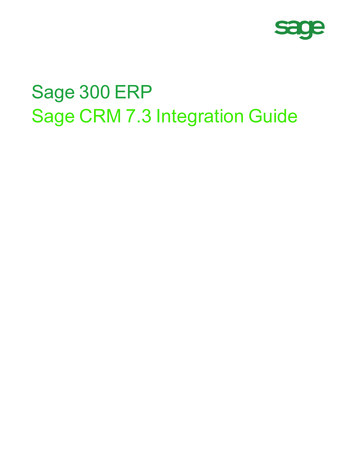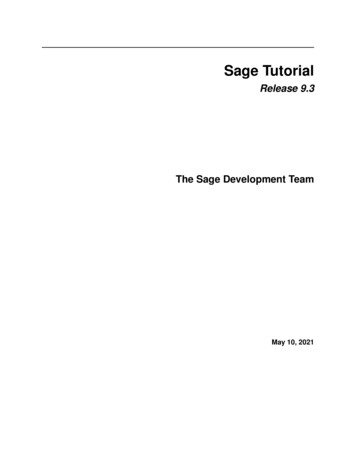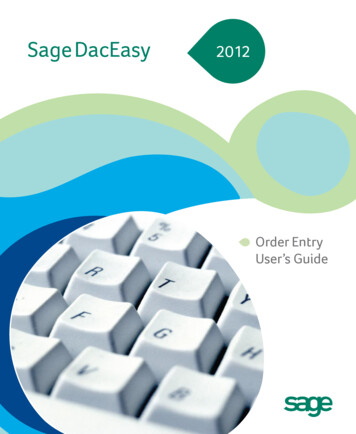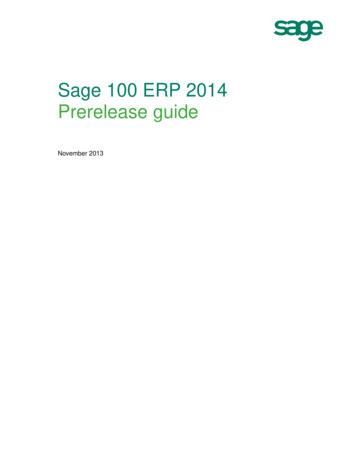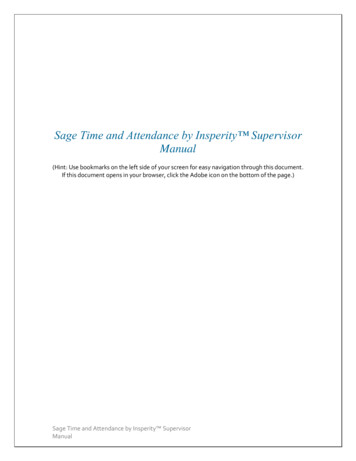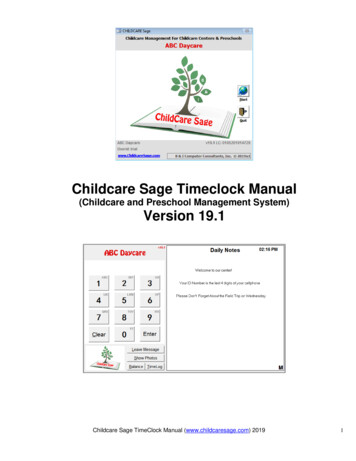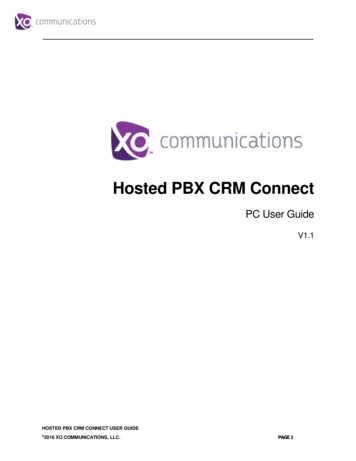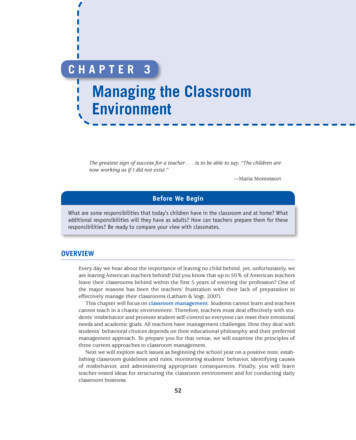
Transcription
CHAPTER 3Managing the ClassroomEnvironmentThe greatest sign of success for a teacher . . . is to be able to say, “The children arenow working as if I did not exist.”—Maria MontessoriBefore We BeginWhat are some responsibilities that today’s children have in the classroom and at home? Whatadditional responsibilities will they have as adults? How can teachers prepare them for theseresponsibilities? Be ready to compare your view with classmates.OVERVIEWEvery day we hear about the importance of leaving no child behind, yet, unfortunately, weare leaving American teachers behind! Did you know that up to 50% of American teachersleave their classrooms behind within the first 5 years of entering the profession? One ofthe major reasons has been the teachers’ frustration with their lack of preparation toeffectively manage their classrooms (Latham & Vogt, 2007).This chapter will focus on classroom management. Students cannot learn and teacherscannot teach in a chaotic environment. Therefore, teachers must deal effectively with students’ misbehavior and promote student self-control so everyone can meet their emotionalneeds and academic goals. All teachers have management challenges. How they deal withstudents’ behavioral choices depends on their educational philosophy and their preferredmanagement approach. To prepare you for that venue, we will examine the principles ofthree current approaches to classroom management.Next we will explore such issues as beginning the school year on a positive note, establishing classroom guidelines and rules, monitoring students’ behavior, identifying causesof misbehavior, and administering appropriate consequences. Finally, you will learnteacher-tested ideas for structuring the classroom environment and for conducting dailyclassroom business.52
Chapter 3Managing the Classroom Environment53OBJECTIVESAfter completing your study of Chapter 3, you should be able to define classroom management, and identify its various aspects; describe the self-discipline approach, instructional approach, and desist approachto classroom management; specify causes of classroom misbehavior; describe organizational techniques that lead to effective classroom management; summarize teacher-tested techniques for proactively preventing classroom managementproblems; and discuss the use of appropriate consequences.Many beginning teachers harbor concerns about their abilities to manage students’behavior. These concerns might be well-founded because teachers, administrators, parents,and students report that misbehavior often interferes with the ability of a teacher to teachand with the ability of students to learn (Charles, 2002; Evertson, Emmer, & Worsham,2003; Gallup & Elam, 1988). Although such reports suggest that there are seriousmanagement and discipline problems in the public schools, it would be a mistake toassume that students are out of control. Let’s explore how effective elementary and middleschool teachers use classroom management techniques to encourage students to assumeresponsibility for their own behaviors.THE ROLE OF CLASSROOM MANAGEMENTClassroom management is the process of organizing and conducting the business of theclassroom. Many perceive it as the preservation of order through teacher control. Classroommanagement is much more than that, however! It also involves the establishment andmaintenance of the classroom environment so that educational goals can be accomplished(Savage & Savage, 2010).Effective classroom managers create orderly, safe environments where students feelvalued and comfortable, thus setting the stage for teaching and learning. To achieve that,they strategically arrange classroom space to support a variety of independent, small andlarge group activities (Crane, 2001). Elementary teachers also designate a large area of floorspace where students can gather for read-alouds, demonstrations, and class meetings. Inall classrooms, there should be no “blind” areas in the room where students can be out ofview. To structure “traffic flow” and minimize disruption, teachers separate high-trafficareas such as group work areas, learning centers, students’ desks, the teacher’s desk,
54P a rt I S e t t i n gtheS tag eforS u c c e ss f u l L e a r n i n gthe pencil sharpener, bookshelves, computer stations, and storage areas. Teachers ensureplentiful room for student movement, especially for students who have physical handicaps.Furthermore, they decide how to store classroom materials, including students’ personalitems, textbooks, resource books, instructional materials, frequently used materials, andequipment. Finally, they decide what materials will be accessible by students and whichareas are designated for teacher use only.Although not its sole component, discipline is another highly important aspect of classroom management. Discipline is a systematic way of teaching students to assume responsibility for their behavioral choices; punishment focuses upon negative consequences formisbehavior. This chapter will focus on discipline rather than punishment even thoughyour success as a classroom teacher will depend on your adequacy in making sound decisions in both of these areas.Effective elementary and middle school teachers create optimal learning environmentsby establishing and enforcing rules, creating caring teacher–student relationships, addressing problem behaviors, and using quality communication. Students of all ages may havebehavioral, attitudinal, and social issues. Older students’ problems, however, are more longstanding and thus more difficult to address. Many middle school students resist authorityand place greater importance on peer norms. Furthermore, because most middle schoolstudents have more advanced reasoning skills than younger students, they generallydemand more elaborate and logical explanation of rules and discipline. Keep these differences between elementary and middle school students in mind as we explore effectiveclassroom management strategies.There are a number of classroom management strategies available to teachers. Let’sbegin by taking a look at three management approaches. These three approaches to classroom management form a continuum, from the self-discipline approach at one extreme,to the instructional approach, to the desist approach at the opposite extreme.The Self-Discipline ApproachThe self-discipline approach is built on the premise that students can be trusted to reflectupon and regulate their behaviors to benefit themselves and others. Advocates for thisdemocratic view of classroom management argue that teachers need to exhibit the dispositions of respect, realness, trust, acceptance, and empathy toward students so they canbuild and establish working teacher-student relationships. Different variations of this management approach include William Glasser’s (1965, 1977, 1986) reality therapy, ThomasGordon’s (1974) teacher effectiveness training (TET), Barbara Coloroso’s (2002) innerdiscipline, and Alfie Kohn’s (1996) beyond discipline.The Instructional ApproachTeachers who use the instructional approach to classroom management preventmost management problems by actively engaging students in high-interest lessonsgeared to meet their interests, needs, and abilities. Thus, students are motivated toattend class, positively participate in activities, and manage their own behavior. JacobKounin (1970) and Frederick Jones (1979) advocate the instructional approach to classroom management.
Chapter 3ReflectionsonManaging the Classroom Environment55Teacher Practice 3.1: Getting Students Motivated1. What evidence suggests that many adolescents are self-centered?Always keep one fact in mind when working with adolescents: developmentally, adolescentsARE self-centered. This is the time they are trying to figure out who they are and how they fit inthe world around them. They want to be unique, but they want to fit in. Rather than trying towork against that developmental characteristic, we’d do better to use it to our advantage.Relevance is a huge issue regardless of what subject or grade level we teach. Most of ushave at some point in our lives asked, “Why do I have to learn this?” (I cried it almost dailywhile taking Geometry in high school; I didn’t see relevance until I took Trigonometry.)I think the key is to NOT water down the curriculum, but, rather, look for ways to bringthe curriculum into our kids’ real lives. It is a task that really forces us to think outside thebox and to get to know our kids and their interests well. For example, when teaching pointof view—specifically the concept of, “How would the story change if this other charactertold the story?”—I have to start with something they already know, usually what they call“He say—she say” stories. Every time I have skipped that step, they continue to change allthe events of the story instead of merely telling it as that other person has interpreted it.Point of view now gets a nod because it makes sense in their own lives.I think the real key with adolescents is to start with them and move the concept outward. It’snot always easy, but my kids are always more successful when I figure out a way to do this.—Ellen, middle-level teacherPlease visit the Student Study site at www.sagepub.com/mooreteachingk8 for additional discussion questionsand assignments.The Desist ApproachThe desist approach to classroom management gives the teacher full responsibility forregulating the classroom. The teacher establishes and enforces a set of specific rules tocontrol student behavior in the classroom. Because the desist approach models of classroom management give teachers power to deal forcefully and quickly with misbehavior,they can be viewed as power systems. This approach probably is the most widely usedclassroom management strategy in today’s schools. The desist approach is advocated byLee and Marlene Canter (1976) in their assertive discipline model and by B. F. Skinner(1968, 1971) in his research on behavior modification.SOURCE: www.middleweb.com. Reprinted with permission.2. If adolescents are self-centered, how would you use this characteristic to make yourteaching more effective?
P a rt I S e t t i n gtheS tag eforS u c c e ss f u l L e a r n i n g“I’d like to overwhelm them with instructional excellence,but I’m not above winning through intimidation.”The three management approaches are summarized in Table 3.1. To help you determineyour own modus operandi, or managerial style, please study the additional informationprovided on the web-based student study site (www.sagepub.com/mooreteachingk8). Howyou respond to management problems will depend on which classroom managementapproach best fits your educational philosophy and your perception of the cause of thestudents’ misbehavior.TABLE 3.1Management ApproachesApproachDescriptionSelf-discipline approachView that students can evaluate and change to appropriate behaviorInstructional approachView that well-planned and well-implemented instruction will preventclassroom problemsDesist approachView that the teacher should have full regulatory power in the classroomSOURCE: Created by Martha Campbell.56
Chapter 3Managing the Classroom Environment57Let’s now look at some of the reasons students misbehave. But first review the approachsummary and complete Reflect and Apply Exercise 3.1.ReflectandApply Exercise 3.1: Approaches to Classroom ManagementReflect What classroom management approaches have your past teachers used? Were theysuccessful? If not, how would you change them? Compare and contrast effective classroom management at the elementary and middleschool levels. Which classroom management approach would be the most effective at thegrade level you expect to teach?Apply Describe how you will arrange your classroom space to promote student self-regulationand to provide a safe, orderly learning environment. Conduct additional research on one of these approaches to classroom management: RealityTherapy, TET, Inner Discipline, Beyond Discipline, Instructional Approach, AssertiveDiscipline, Discipline with Dignity, CHAMPS, Achieve, or Boys/Girls Town Social SkillsPrograms. Be ready to share.CAUSES OF MISBEHAVIORTeachers who are ineffective classroom managers spend much of their time franticallyputting out small “fires.” They need to learn a lesson from professional firefighters—the bestway to deal with a fire is to prevent it from happening in the first place. Proactive classroommanagers create “fireproof” classroom environments by addressing causes of misbehaviorthat might fuel emotional explosions. Some misbehaviors are sparked by conditions that arenot readily obvious. According to Maslow, once their physiological needs are met, studentsare motivated by the need to be physically and emotionally safe, loved and accepted, admiredand respected, and personally fulfilled. A careful examination of students’ classroombehaviors, desirable as well as undesirable, can reveal that they are influenced by forces andpressures inside and outside the classroom. Identifying and addressing these issues willproactively prevent future behavioral conflagrations (Belvel, 2010).Home EnvironmentStudents do not leave their concerns and confusion about family situations at the classroom door. Parents are students’ first teachers. Not all parents teach their children to
58Video Link 3.1:Watch a videoabout principles ofcultural proficiency.P a rt I S e t t i n gtheS tag eforS u c c e ss f u l L e a r n i n grespect themselves and others, to respond to authority figures, and to follow the goldenrule. Parents’ attitudes toward the importance of education are often mirrored by theirchildren. If parents do not see the purpose of studying hard to prepare for a future career,their children will balk at school work, too.Lack of supervision in the home is a common problem in our society. Many studentscome from single-parent homes or from homes where both parents are too busy with thei
Jacob Kounin (1970) and Frederick Jones (1979) advocate the instructional approach to class - room management. Chapter 3. Managing the Classroom Environment. 55. The Desist Approach. The desist approach. to classroom management gives the teacher full responsibility for regulating the classroom. The teacher establishes and enforces a set of specific rules to control student behavior in the .


